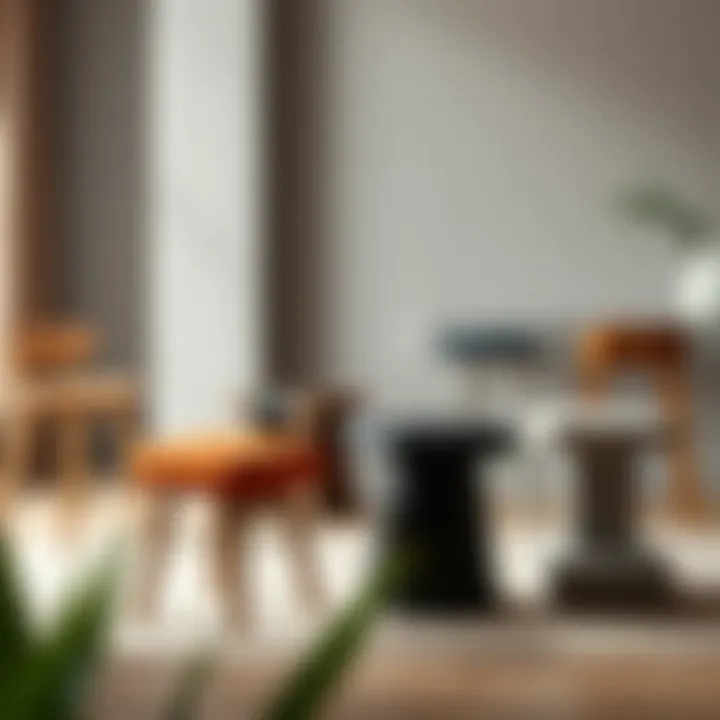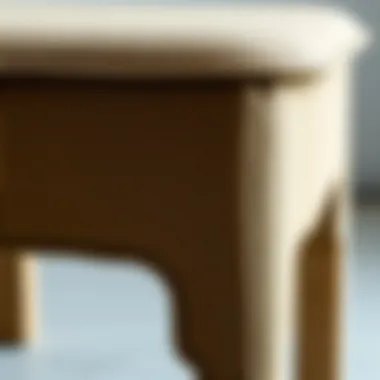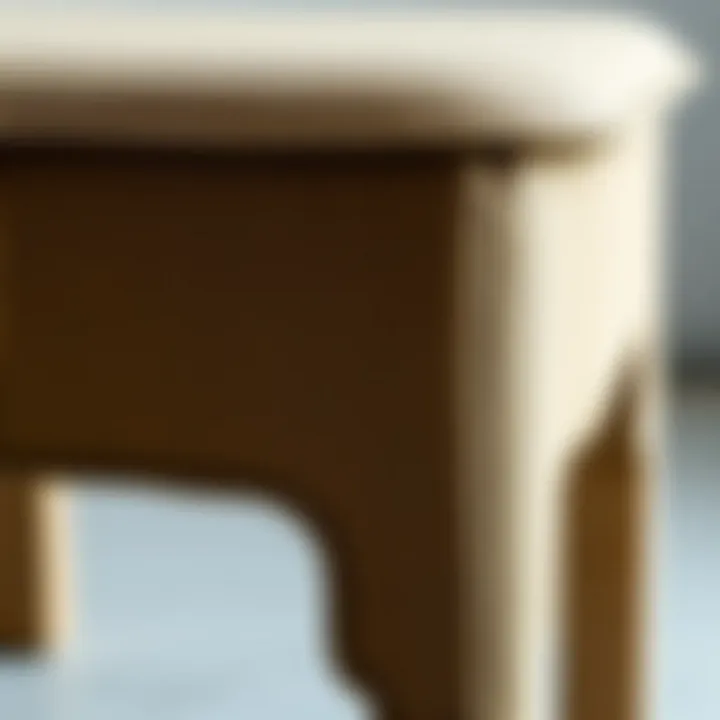Exploring Square Stool Chairs: Design and Functionality


Intro
Square stool chairs are often underestimated in the world of furniture design. Unlike their more opulent counterparts, these stools have a charm all their own, merging utility with aesthetic appeal. Their roots stretch back to various cultures, each contributing to the evolution of their design. In this exploration, we will navigate the rich history and multiple facets of square stool chairs, examining their unique attributes, practical applications, and how they fit into contemporary design trends.
By the end of this article, readers will not only understand the significance of square stool chairs but will also find practical guidance on how to incorporate these versatile pieces into their own living spaces.
Furniture Styles and Trends
Modern vs. Traditional: Understanding the Key Differences
When we talk about square stool chairs, the debate often centers around modern versus traditional design. Modern stools, typically characterized by clean lines and minimalistic features, embrace materials like metal, plastic, or sleek wood finishes. They fit seamlessly into contemporary settings where open spaces and functionality reign supreme.
On the flip side, traditional stools embrace a more rustic charm, often featuring ornate carvings and rich, dark woods. They evoke a sense of history and craftsmanship, connecting the household with its roots.
Even if both styles serve a similar purpose, the atmosphere they create differs greatly. A modern square stool can make a small kitchen feel airy, while a traditional piece might lend warmth to a cozy dining area.
Top Furniture Trends to Watch in
As we weave through the design landscape of 2023, several trends are emerging that spotlight square stool chairs:
- Sustainable materials: More consumers are being selective about the materials in their furniture, with a noticeable tilt towards eco-friendly options. Look for stools made from reclaimed wood or recycled materials.
- Multifunctional design: Square stools are evolving to serve multiple purposes—from extra seating to side tables—adapting to the dynamic needs of modern living.
- Bold colors: Gone are the days of neutral palettes being the only choices. This year, we see vibrant hues making a comeback, adding not just functionality but also character to spaces.
"Furniture trends reflect the tastes of both the market and the environment we are in; adapting to consumer needs is key to staying relevant."
Practical Tips for Furniture Selection
How to Choose the Right Furniture for Your Space
Choosing square stool chairs that harmonize with your interior can be daunting. Here are some guiding points to consider:
- Measure your space. This sounds simple, but proper measuring ensures that your stools will fit well without overcrowding.
- Consider the material. From metal to timber, your choice can dictate the overall vibe of your space. For instance, a glossy metallic stool might suit a modern kitchen, while a wooden option could complement a rustic living area.
- Think about usage. Will these stools be for occasional seating, or should they withstand daily wear and tear? This decision will impact your material and design choices.
Sustainable Furniture: Tips for Eco-Friendly Choices
Sustainability in furniture design is not just a trend; it’s a necessity:
- Opt for stools made from sustainable resources, such as bamboo or reclaimed wood, to minimize environmental impact.
- Look into brands that prioritize ethical production practices.
- Consider second-hand or vintage stools, which add character and reduce waste.
By keeping these considerations in mind, homeowners, designers, and DIY enthusiasts can unlock the full potential of square stool chairs, integrating them as functional art pieces rather than mere furniture.
For more information on sustainable furniture options, check out Sustainable Furnishings Council or explore ideas on platforms such as Pinterest.
As we continue, prepare to delve deeper into the myriad of styles, materials, and unique factors that define square stool chairs and how they can elevate your living spaces.
Prelims to Square Stool Chairs
In the vast arena of interior design, square stool chairs emerge as unsung heroes, blending functionality with esthetic charm. These pieces are not only practical additions to any living space but also serve as versatile accents that can elevate a room's visual appeal. Their square shape allows for easy nesting and versatility in placement, making them ideal for various settings from cozy homes to bustling cafés.
Definition and Characteristics
Square stool chairs are typically characterized by their four-cornered seats that offer a stable surface for sitting. Their designs often incorporate a minimalist aesthetic, where simplicity reigns yet is complemented by a touch of flair. Dimensions can vary, but the concept generally revolves around compact, sturdy construction. Common materials include wood, metal, and plastics, with finishes that range from the natural grain of timber to striking paints that catch the eye.
These chairs usually lack arms and backs, resulting in a low-profile design that can seamlessly integrate into a variety of spaces. Their height can either mirror standard table seating or be slightly lower, catering to different needs like bar settings or informal gatherings. Features might include stackability for efficient storage or cushioned tops to increase comfort during extended use.
Historical Background
The evolution of square stool chairs can be traced back to ancient times when stools served as some of the most basic forms of furniture. In these early days, stools were crafted from local materials and simple construction techniques, enabling their use across a range of societies. Fast forward to the Age of Enlightenment, where design began to play a larger role in furniture, the square stool evolved from mere functional pieces into items of artistic expression.
In the mid-20th century, design revolutions brought about a surge in creativity and variations. The modernistic movements led to the experimentation of forms and materials, making square stools a canvas for various craftsmanship techniques. Designers like Charles and Ray Eames embraced the stool's simplistic design while enhancing comfort and esthetics, thereby influencing contemporary styles. Today, their appeal continues as they find homes in stylish apartments, commercial spaces, and even outdoor settings.
As we continue to navigate through the artistic interpretations and practical functionalities of square stool chairs, it's insightful to appreciate not just their superficial designs but also their rich history and evolution as a staple piece in furniture.
Design Variations of Square Stool Chairs
Design variations in square stool chairs are crucial in understanding their role in both functionality and aesthetics. These designs cater to varied tastes and practical needs, making the square stool a versatile choice for different settings. Homeowners, designers, and retailers alike should appreciate how these different styles align with personal preferences, practical applications, and the overarching theme of contemporary design.
Modern Aesthetics
Modern aesthetics often lean towards minimalism, emphasizing sleek lines and a clean look. Square stool chairs designed with this in mind feature materials like polished metals, clear acrylic, or smooth woods. An example would be a stool made of plywood with a matte finish, evoking a sense of effortless elegance. The beauty of modern square stools lies in their simplicity and adaptability. They can easily blend into a wide range of environments, from a contemporary loft to a chic office space.
Aspects to consider include:


- Functionality: They are lightweight, allowing for easy movement and reconfiguration.
- Color Schemes: Neutral tones combined with bold accents enable these stools to become statement pieces or subtle additions, depending on the desired effect.
- Multifunctionality: Many modern designs incorporate features like storage or stackability, enhancing their utility.
Traditional Styles
Traditional square stool designs take cues from classic craftsmanship and historical contexts. Here, the focus shifts to ornate details, rich woods, and upholstery that reflect cultural heritages. For instance, a sturdy oak stool, hand-carved with intricate patterns, can serve not only as a seat but also as a conversation starter.
These stools typically highlight:
- Material Choices: Solid woods such as mahogany or walnut, which not only provide durability but also exude warmth and elegance.
- Craftsmanship: Attention to detail distinguishes this style, making each piece unique and rich in character.
- Timelessness: Traditional designs never truly go out of style; they offer longevity in both visual appeal and structural integrity.
Eclectic and Artistic Designs
Eclectic styles provide a refreshing take on square stools, showcasing creativity and individuality. These designs often merge various materials, colors, and patterns to create unique statements that can liven up any space. One might find a square stool featuring a mosaic of reclaimed wood or a bold geometric print fabric that draws the eye.
Key elements of eclectic square stools include:
- Innovative Use of Materials: Combining materials that wouldn’t traditionally go together adds a whimsical touch to interiors.
- Artistic Flair: Furniture becomes an art piece, speaking to the personality and preferences of the owner. Consider stools painted with unconventional motifs or those embellished with artistic decals.
- Customization: The potential for DIY projects is immense in this style. Homeowners can personalize their stools, either through painting or by selecting varied upholstery, creating a truly one-of-a-kind piece.
"Square stool chairs are not just functional objects; they embody the essence of the designs they represent."
Without a doubt, the design variations within square stool chairs cater to a broad spectrum of tastes and needs. A thoughtful selection ensures that whether one is curating a modern living space, honoring tradition, or expressing artistic flair, there’s a square stool that fits the bill.
Functionality of Square Stool Chairs
Square stool chairs are not just aesthetically pleasing; they bring a world of functionality to various settings. In this section, we’ll dig into how these versatile seats cater to the needs of homeowners, designers, and anyone looking for practicality without sacrificing style. From casual gatherings to more formal events, the importance of function in square stool design cannot be overstated.
Utilitarian Features
The utility of square stool chairs shines through in several key features that make them an ideal choice for many spaces. Here are a few noteworthy aspects:
- Compactness: Square stools tend to have a smaller footprint compared to traditional chairs. This makes them particularly useful in tight spaces like city apartments, where square footage is at a premium.
- Lightweight Design: Many square stools are crafted from lighter materials. This facilitates easy movement around the home or outdoors, allowing you to quickly rearrange layouts for different occasions.
- Multi-Use Purposes: Whether you’re sitting at a kitchen island, adding extra seats for guests, or even using them as side tables, square stools adapt effortlessly to various roles. They can easily slip under tables or be stacked when not in use—truly maximising functional space.
These characteristics bolster the versatility of square stools, making them an ideal option for homeowners who appreciate functionality without refusing aesthetics.
Space-Saving Solutions
In today’s world, where space is often limited, square stool chairs offer commendable space-saving solutions. Here are a couple of strategies that showcase why these stools can be your best friend when dealing with confined areas:
- Stackability: A good number of square stools are designed to be stackable. This property allows for quick storage and keeps your space uncluttered. After entertaining guests, for example, stacking these stools can help return your living area to its peaceful state without a hassle.
- Nesting: Some designs even embrace the nesting concept, allowing stools to fit snugly together. This maximizes area while keeping your furniture organized and neat. D e p e n d in g on your needs, these stools can be pulled apart or tucked away as needed, providing flexibility without sacrificing style.
- Dual-Purpose Designs: Certain square stools come with added functionality, like hidden storage within their frames. This allows for easy access to items while maintaining a clean visual flow.
"Space-saving designs in furniture can often redefine the feel of a room, making it more breathable and organized."
Overall, square stool chairs not only provide seating but also embody clever design solutions that transcend mere functionality. They solve space dilemmas while offering style, fitting seamlessly into diverse home styles and layouts.
Materials Used in Square Stool Chairs
Understanding the materials used in square stool chairs is crucial for anyone interested in furniture design, whether you're a homeowner redecorating your space or a designer sourcing new pieces. The choice of materials influences not just aesthetics but also functionality, durability, and ease of maintenance. Each material brings its own set of characteristics, making it essential to consider your lifestyle and design vision when selecting square stools.
Wood Options
Wood has been a staple in furniture making for centuries, and it’s easy to see why. When it comes to square stool chairs, wood offers a warmth that other materials often lack. Popular choices include oak, maple, and walnut, each with distinct grains and finishes.
- Oak is known for its durability and resistance to scratches, making it perfect for high-traffic areas.
- Maple, being lighter in color, can blend seamlessly with other wooden furniture, providing versatility in design.
- Walnut stands out with its rich hues and elegant patterns, adding a touch of sophistication.
One must also consider whether you prefer solid wood for longevity or plywood for a more economical option. Solid wood tends to be more stable, while plywood can be easier to shape into intricate designs. Furthermore, proper finishing treatments can enhance the wood's longevity and make cleaning a breeze, which is especially beneficial for dining or bar stools exposed to spills.
Metal and Plastic Alternatives
Metal and plastic have carved out their own niche in the realm of furniture, especially for square stool chairs that prioritize modernity and industrial aesthetics. Metal stools often feature sleek lines and are incredibly durable under pressure, making them an excellent choice for both indoor and outdoor use.
- Steel, in particular, is renowned for its strength and can be treated to resist rust, ideal for outdoor patios. The minimalist look appeals to those who favor contemporary design.
- Aluminum is lighter and also resistant to corrosion but offers a different feel altogether. It’s perfect for moving around spaces, especially in a dining setting.
On the other hand, plastic stools are a popular choice for kids' spaces or casual settings due to their lightweight and easy-to-clean nature.
- Polypropylene is particularly favored because it comes in many colors and is resistant to fading from sunlight—perfect for both indoor and outdoor settings. Plus, they often come with a range of fun and eye-catching designs that can brighten any space.
Fabric and Upholstery Choices
While wood and metal are cornerstones in stool design, fabric upholstered stools add a layer of comfort and personalization that bare materials often lack. When choosing upholstery, factors like texture, ease of cleaning, and durability become pivotal.
- Leather gives a sophisticated air and is relatively easy to maintain, provided it’s treated properly. It's perfect for a sleek, high-end look in more formal dining areas.
- Microsuede or Velvet, on the other hand, can add richness and warmth but may be more vulnerable to stains, making them better suited for low-traffic spots.
- Outdoor fabrics, often made from synthetic materials, can dramatically increase durability against the elements. These fabrics are engineered to resist fading, moisture, and mildew—ideal for patio or garden settings.
In summary, material selection plays a significant role in how square stool chairs fit into various environments and lifestyles. Whether one prefers the organic charm of wood, the sleekness of metal, or the cozy feel of upholstery, there’s a vast array of options available.


"Choosing the right material not only defines the aesthetic but also influences the experience you’ll have with the stool—and that’s worth putting some thought into."
With an eye toward sustainability, many manufacturers now also focus on recycled or upcycled materials, reflecting a growing trend in eco-conscious consumerism. Whether it’s through artisanal wood selections or innovations in synthetic fabrics, the material choices today extend far beyond mere preference, shaping how these pieces contribute to a greener future.
Ergonomic Considerations
When designing or selecting square stool chairs, ergonomics plays a crucial role in ensuring comfort and utility. This aspect is especially pertinent when these stools are employed in settings where people spend significant amounts of time, such as home bars, kitchen counters, or workspaces. The focus should be on how well the chair can accommodate the human body, reducing strain while promoting good posture. Understanding ergonomic principles not only benefits the user’s comfort but also enhances their overall experience with furniture.
Height and Comfort Alignment
Height alignment is arguably the most significant consideration when choosing square stool chairs. A stool that aligns with the height of the countertop or table is essential to maintaining a comfortable, natural position during use. If the stool is too high or too low, it forces the user into awkward postures that can lead to discomfort or injury over time.
To enhance comfort, the seat's height should allow the user to sit with their feet flat on the floor while keeping their knees at about a 90-degree angle. For instance, in a kitchen setting, the optimal stool height is generally around 24 to 26 inches for counter seating. Conversely, bar-height stools often measure between 28 to 30 inches. Selection of the right height can significantly affect the user experience and longevity of use.
Support and Stability
In addition to height, support and stability are foundational to the ergonomic design of square stool chairs. Users need to feel secure and well-supported in their seating choice. Stools with broader bases offer stability, ensuring that the stool doesn’t tip under weight shifts. This becomes particularly important in high-traffic areas or when the seating needs vary between children and adults.
The backrest of a stool, if present, also contributes to support. An angled back can help distribute the user’s weight evenly, and prevent slouching which is a common issue with sleek designs that lack back support. For those who prioritize aesthetics, it's worth noting that stools with a well-designed support system can still possess a sleek appearance without compromising on function.
"In the world of furniture, comfort and utility should never be second class to style. An ergonomic chair is not just a seat; it's an investment in health and well-being."
Understanding these principles can help homeowners, designers, and DIY enthusiasts alike make informed choices in their furniture selections, fostering environments that are both stylish and conducive to good posture.
Placement Strategies in Interior Design
The way square stool chairs are positioned in a space can drastically alter its look and functionality. It's like giving a room a tailored suit, ensuring everything fits just right. Placement is not merely about where to stick a chair; it involves considering flow, accessibility, and visual harmony. Properly planned placement can enhance the aesthetic appeal of a room, while also maximizing its utility. Homeowners and designers alike must pay close attention to how these stools integrate into various settings to achieve their full potential.
Living Room Applications
When it comes to the living room, square stool chairs can serve as versatile accessories. They can act as accent pieces or provide additional seating when friends drop by. Placing a couple of square stools around a coffee table can encourage conversation, as they can be easily rearranged to fit large or small gatherings.
To create a cohesive look, consider matching the stools with nearby furniture. For example, if the sofa has warm tones, choose seating with similar hues or textures. It’s also crucial to maintain enough space or flow between furniture pieces. A common rule of thumb is to leave about 18 inches between the stools and the coffee table for ease of movement.
Dining Areas and Bar Settings
In dining spaces, square stools can be a wonderful alternative to traditional dining chairs or bar stools. Their compact nature makes them ideal for spaces that crave flexibility. Imagine a minimalist kitchen with sleek cabinetry—pairing it with square stools adds modernity while ensuring there's no unnecessary bulk.
For bar settings, especially at home, placing square stools against a counter not only provides seating but can also create a casual atmosphere for morning coffee or evening cocktails. Height is key here; ensuring the stools align well with the counter height is crucial for comfort and usability. Don’t forget to think about how lighting plays into this; a vibrant pendant above can bring warmth and personality to the setting.
Outdoor and Patio Uses
Square stool chairs can work wonders in outdoor environments, breathing life into patios and gardens. They can serve multiple purposes, from extra seating to small tables for placing drinks and snacks. In a setting with lush greenery, a few vibrant stools can serve as delightful pops of color.
When placing stools outdoors, consider both durability and convenience. Materials should withstand various weather conditions, so opting for powder-coated metal or treated wood is wise. Also, think about placement in relation to sun and shade. A lounge area with square stools stacked around fire pits or barbecues creates an inviting space for gatherings.
In summary, the placement of square stool chairs is more than just a decision of convenience. It’s an opportunity to craft an environment that reflects style and functionality. By paying attention to how these versatile pieces fit into different settings, homeowners and designers can dramatically enhance living spaces, ensuring each square stool chair becomes an asset in its own right.
Square Stool Chairs as Statement Pieces
Square stool chairs are not just seats—they're focal points in any room. Their unique shapes and versatility allow them to stand out in a way that traditional seating often does not. Incorporating these chairs into your interior design can transform a mundane space into something striking and memorable.
It's important to consider how square stools can be used to make bold fashion statements. Unlike ordinary chairs that blend seamlessly into the background, square stools demand attention due to their geometric design and potential for artistic expression. With numerous options available, each stool can embody the character of its environment, whether it’s a sleek urban apartment or a cozy cottage.
Bold Colors and Patterns
When it comes to making a statement, color is king. Bold colors can serve as an artistic flare that catches the eye, adding depth to your design layout. Imagine a bright orange square stool contrasting against muted, neutral surroundings—it instantly draws focus and provokes conversation.
Different patterns can also enhance the visual appeal of your space. From vibrant geometric prints to whimsical floral designs, the square stool can serve as a canvas for creativity. For example:
- Graphic Prints: These can provide an energetic vibe, great for modern or eclectic themes.
- Floral or Nature-Inspired Patterns: Ideal for a more vintage-style setting, offering warmth and familiarity.
- Stripes and Checkers: These patterns can add dynamism and interest, particularly in contemporary decor.
Integrating bold colors and patterns into square stools means taking risks, but the payoff can be stunning. They become more than just functional pieces; they transform into artistic elements within the room.
Textural Contrast
Beyond color, textural contrast enhances the visual and tactile appeal of square stool chairs. Pairing materials can create stunning effects. For instance, imagine a sleek metal-framed stool topped with a plush velvet cushion. The juxtaposition of hard and soft materials intrigues the senses and can enrich the overall design.
Here are some combinations to consider:
- Wood and Metal: Wooden tops with metal bases can evoke rustic charm paired with industrial flair.
- Fabric and Leather: The softness of fabric contrasts nicely with the striking smoothness of leather, providing a luxurious touch.
- Glass and Wood: A glass-top square stool with an intricate wooden base can create an effect of transparency and elegance.


Using diverse textures opens up new dimensions in your living space. It invites touch and exploration, ensuring that these stools—far from being mere seating options—become engaging statements of style and substance.
When design embraces boldness in color and texture, square stool chairs can emerge as the star of the show, demanding attention while confidently establishing their place in your home.
Sustainability in Furniture Design
In today's world, sustainability is not just a buzzword; it's a vital principle that pervades various aspects of our lives. The furniture industry, too, has felt the shockwaves of the sustainability movement. When it comes to square stool chairs, their design and manufacturing processes can greatly influence our planet's health. It's no longer sufficient for furniture to be merely attractive or functional; it must also reflect a commitment to environmentally friendly practices.
One of the main considerations in sustainable furniture design is the materials used. As homeowners, designers, and retailers increasingly endorse eco-conscious choices, opting for durable and renewable resources becomes paramount. That’s where eco-friendly materials come into play.
Eco-Friendly Materials
When discussing eco-friendly options for square stool chairs, several materials stand out:
- Bamboo: This rapid-growing grass is not only sturdy but also regenerates quickly without the need for fertilizers or pesticides. Its use in furniture underscores a commitment to sustainable sourcing.
- Reclaimed Wood: Utilizing wood that has been salvaged from old buildings or furniture reduces the demand for new timber. This choice adds character to each piece while minimizing environmental impact.
- Recycled Plastics: These materials are reshaped to create sturdy seating options, diverting waste from landfills.
- Natural Fabrics: When it comes to upholstery, materials like organic cotton, linen, or hemp offer eco-friendly alternatives that contribute to a smaller carbon footprint.
These materials not only enhance the chair's aesthetic but also embody a ethos of caring for the environment, appealing to a growing demographic that prioritizes sustainability in their purchasing choices.
The Life Cycle of Square Stools
Understanding the life cycle of square stools provides insights into their long-term viability and environmental impact. This cycle starts from material selection right through to disposal, comprising several key phases:
- Material Sourcing: Choosing responsible suppliers who practice sustainable harvesting and production methods.
- Manufacturing Process: Assembling the chair using methods that minimize waste and energy consumption, such as lean manufacturing techniques.
- Usage: Encouraging longevity in design; well-made square stools can last for years, with maintenance strategies ensuring they remain in good condition.
- End of Life: Considering how these chairs can be recycled, repurposed, or biodegradable options that won’t linger in landfills forever.
Through each of these phases, stakeholders—from designers to consumers—play a role in contributing to a more sustainable future. Understanding this life cycle not only informs better purchasing decisions but also fosters a culture of responsibility toward our environment.
The growing preference for sustainable furniture signifies a shift towards greener, more responsible living that aligns with modern values.
This holistic approach to sustainability in furniture design not only benefits the environment; it enhances the value of square stool chairs, ensuring they remain an attractive option in various settings, from homes to cafes.
DIY Square Stool Chair Projects
Exploring DIY square stool chair projects is a gateway to personal expression in furniture design. This section emphasizes the importance of engaging in creative endeavors, offering a unique opportunity not just to customize furniture but to also foster sustainability and resourcefulness in home decor. By tapping into the world of DIY, individuals can breathe new life into old stools, making them functional art pieces suited to their spaces. Furthermore, taking on such projects can be rewarding, both emotionally and economically, leading to remarkable transformations.
When engaging with DIY square stool chair projects, it’s vital to consider a few essential elements. One's skill level, the tools available, and the desired outcome play significant roles in the project’s success. These projects don’t just serve aesthetic purposes; they allow for practical improvements and adjustments suited for various lifestyles, all while potentially reducing waste.
Here are some benefits of pursuing DIY square stool projects:
- Creativity: Experimenting with colors and materials can lead to one-of-a-kind pieces.
- Savings: Upcycling old furniture often costs a fraction of what new furniture would.
- Sustainability: Using sustainable materials minimizes your environmental impact.
- Customization: Tailoring designs to fit your needs ensures that the furniture serves its purpose effectively.
Simple Upcycling Ideas
Upcycling is at the heart of many DIY projects. Breathing new life into worn-out square stools not only enhances their aesthetic appeal but also addresses practicality in design. Here are a few straightforward upcycling ideas:
- Repainting: A coat of fresh paint can dramatically alter the look of a stool. Opting for bold or matte colors can complement your existing decor.
- Stenciling: Adding patterns or designs through stenciling can personalize a square stool, allowing it to stand out or blend seamlessly into your home.
- Adding New Legs: Swapping out the original legs for something a bit more stylish can elevate the stool’s design, too. Consider using hairpin legs or even reclaimed wood for a rustic effect.
- Fabric Upholstery: If the seating surface is worn or outdated, a simple reupholstering job can work wonders. Using durable, easy-to-clean fabrics can also be practical and stylish.
Making these changes not only revitalizes the furniture but offers a practical approach to integrating sustainability into daily life.
Customizations and Personalizations
Customizing square stool chairs opens the door to endless possibilities. The variety in projects allows for tailored solutions that cater to individual preferences. Here are some ideas to get the wheels turning:
- Cushioning: Adding cushioning or ergonomic seating surfaces can enhance comfort, elevating the stool from mere decoration to a functional piece of furniture.
- Integrated Storage: Designing a stool that can double as a storage unit – think of a small wooden box with a padded top – can be both clever and highly functional.
- Artwork Integration: If you're looking to turn your stool into an artistic statement, consider using decoupage techniques featuring favorite images or patterns.
- Lighting Elements: For a more adventurous route, installing ambient lighting beneath the stool can create an atmospheric glow that enhances any room’s ambiance.
Involving yourself in DIY square stool chair projects not only empowers creativity but also nurtures personal style, ensuring each piece reflects individual taste and functionality.
"The beauty of furniture is not solely in its appearance, but in its ability to tell a story through the hands that craft it."
By exploring these DIY projects, you can create pieces that speak to your preferences, meet your needs, and resonate with values of resourcefulness and individuality.
End and Future Trends
As we bring our exploration of square stool chairs to a close, it becomes evident that these versatile pieces are not merely functional but are also emblematic of broader shifts in furniture design and consumer behavior. Understanding the future trends surrounding square stools is crucial for homeowners, designers, and DIY enthusiasts alike. The evolution of design is often driven by a combination of innovative materials, aesthetic desires, and practical needs, all merging to create pieces that fit seamlessly into our diverse lifestyles.
Innovations in Square Stool Design
Innovation in square stool design has taken center stage, ushering in a wave of opportunities for both creators and consumers. Recent advancements focus on several key areas:
- Smart Materials: Designers are increasingly utilizing smart materials that not only enhance the aesthetic appeal but also possess functional benefits. For instance, chairs that can change color or even texture in response to temperature or lighting conditions exemplify the landscape of modern design.
- Customizability: More brands are offering customizable square stools. Shoppers can often choose from different heights, colors, and fabrics, making these stools versatile to individual needs. This level of personalization enhances not just the utility but also the sentimental value of the furniture.
- Sustainable Practices: With an ever-growing emphasis on sustainability, many manufacturers are combining style with responsibility. By adopting eco-friendly materials and production methods, they’re not only creating stylish pieces but also fostering a sense of environmental stewardship among consumers.
"Innovation does not merely arise from new technologies; it burgeons from our changing lifestyle and expectations."
Evolving Consumer Preferences
Consumer preferences have become a significant force in shaping the market for square stool chairs. Trends emerging from this evolution include:
- Minimalism: There’s a clear tilt towards minimalist design. Homeowners are opting for pieces that are sleek and functional, devoid of unnecessary embellishments. This not only reflects a shift towards simplicity but also makes cleaning and maintenance a breeze.
- Multifunctionality: Square stools today are being designed to serve multiple purposes. A simple stool can easily double as a side table, a storage solution, or even as extra seating when unexpected guests arrive. Consumers are drawn towards items that serve more than one purpose, allowing for efficient use of space.
- Experience Over Ownership: A defining trait of modern-day consumers is their inclination towards experiences rather than sheer ownership. Many are looking to enhance their living spaces in ways that promote comfort and togetherness. Thus, square stools can transform not just spaces, but social interactions, serving as a platform for gatherings, discussions, and relaxation.
In summary, the journey through the realms of square stool chairs reveals not only the design evolution but also the shifting paradigms of consumer choice. As we step into a future that values functionality, sustainability, and personalization, the square stool will undoubtedly continue to evolve, cementing its place within the contemporary furniture landscape.







